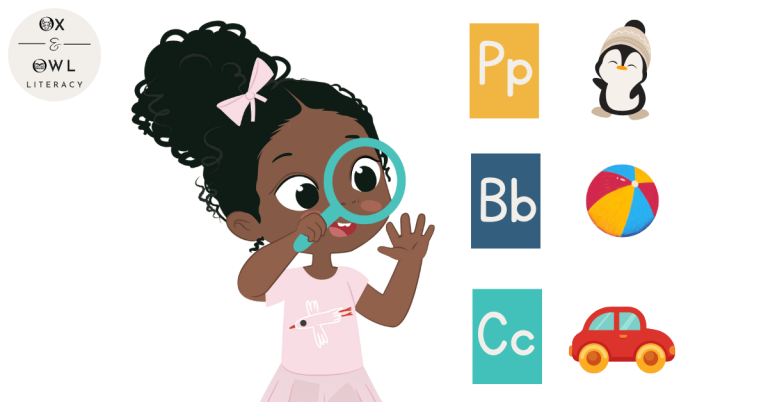Sound Architecture: Constructing Strong Foundations through Letter Sound Accuracy
Are you pronouncing the single letter phonemes of the alphabet correctly when teaching your little one their sounds?

Mastering letter-sound connections is an important step toward unlocking the wonders of language for our little learners. As educators and caregivers, we play a pivotal role in laying the foundation for language development by unraveling the mysteries of these distinct phoneme sounds (the smallest sounds that make up words).
Central to this foundation is the accurate pronunciation of phonemes. Two key categories of phonemes, stop sounds and continuous sounds, play a pivotal role in shaping a child’s letter knowledge skills.
When we model clear and accurate pronunciation, children gain confidence in their own ability to produce and understand sounds. This confidence is a key driver in fostering a positive attitude toward literacy.
Continuous Phoneme Sounds & Stop Phoneme Sounds
When helping children with phonemic skills, such as
learning to isolate, blend, and segment phonemes, we need to
be intentionally thinking about whether sounds are continuous
or stop sounds.

When introducing children to phonemic tasks and phonics applications, it’s important to understand that continuous sounds and stop sounds are pronounced differently and this influences how they should be said. If stop sounds are elongated, you may be developing your child or student’s ear for unnatural language patterns that won’t help with learning to decode and spell.
When learning to apply letter-sound knowledge to print (decode) words, some children tend to pause and not blend stop sounds into the next phoneme sound. Say for example, instead of reading the word ‘kite’ smoothly, some children may read it as /k/ pause /igh/ pause /t/, rather than bumping the sounds into one another. This is because both the /k/ and /t/ sounds are phoneme stop sounds.
Continuous Sounds:
These are spoken sounds made from a continuous flow of air which does not cause the sound to become distorted.
Continuous sounds include all vowels and the consonants f, l, m, n, r, s, v, w, y, & z.
Typically continuous sounds are taught first during phonemic blending and segmenting activities because they’re easier to learn.
Stop Sounds:
These are spoken sounds that are made when air is blocked and then released. They are also known as plosives.
Stop sounds include the consonants b, c, d, g, j, k, h, p, q, t, & x.
It’s important to keep stop sounds pure by quickly cutting them off, preventing the addition of the schwa /uh/ sound that can occur to make sounds like /d-uh/ and /k-uh/.
Another thing to note is that when we are teaching letter sounds, we may tend to add an /uh/ sound to the end of stop phonemes when stretching them out to emphasize the sound. Let’s take the stop sound /k/ as mentioned above as an example, instead of a pure /k/ sound, we may start pronouncing it as /kuh/, but the word ‘kite’ is not pronounced /kuh/ /igh/ /t/.
Try This Stop-Sound Exercise
Try this simple exercise to help understand what is meant by the schwa (‘uh’) sound.
- Segment the word ‘pal’ into its phoneme sounds /p/ /a/ /l/.
- Now try the ‘snail talk’ method of saying each sound aloud and elongating only the continuous sounds of /a/ and /l/.
Tricky right?
There is a tendency to add ‘uh’ to the /p/ sound, making the sound /p-uh/. This is however incorrect because we do not pronounce the word ‘pal’ as /p-uh/a/l/.
Catching ourselves with phoneme stop sounds can sometimes be tricky, so being aware of them and noting how you are pronouncing them is a good practice to get in the habit of.
The Dynamic Duo

Help your little learner identify beginning, middle, and end sounds using visual aids like Elkonin boxes. For example, draw three boxes and use small objects or counters to represent sounds in words.


Phonemic awareness is the key to unlocking the world of reading! It’s perfectly fine if some kids need a little extra time to get the hang of it. Make learning fun by tailoring activities to their developmental level and watching them grow step by step!
Tricks with Continuous Letter Sounds and Stop Letter Sounds
To illustrate how to easily identify continuous letter sounds from stop sounds and to help know they are getting pronounced properly, try the following simple exercises.
Check for Air Puffs vs Vibrations
Hold your hand in front of your mouth about an inch or two away. Compare the sound /b/ with the sound /m/.
Hold your hand gently across the front of your throat (larynx). Again, compare these two sounds.
Did you notice the puff of air against your hand when you pronounced the /b/ sound?
Did you feel the vibrations when you pronounced the /m/ sound?
You’ll notice a pattern: Stop sounds will all create a puff of air and most of the continuous sounds will make a felt vibration.
This is why stop sounds are sometimes referred to as ‘breath sounds’, and the continuous sounds as ‘motor sounds’.
When in Doubt, Blend
Try saying the word ‘pal’ using the ‘snail talk’ method, however, this time blend the stop sound /p/ with the continuous /a/ sound next to it, followed by the continuous /l/ sound (/pa/ /l/).
Do you notice the difference? It should seem easier and eliminate the attached schwa (‘uh’) sound to the /p/.
Regardless, it simply comes down to knowing that stop sounds get pronounced quickly and continuous sounds get elongated/stretched out in phoneme segmenting activities.
Use Physical Gestures
Associate stop sounds and continuous sounds with a visual cue or gesture to help remember and differentiate between stop and continuous sounds.
For example:
For stop sounds like /b/, /p/, /t/, and /k/, you can use a closed fist to represent the stopping action.
For continuous sounds like /l/, /r/, /s/, and /a/, you can wave your hand through the air in one continuous stroke as you say the sound.
NOTE: there is no need for children to learn these terms or memorize which letters belong to the group of continuous sounds and which belong to the group of stop sounds.
Key OOliteracy Takeaways
Nurturing Little Minds, Sparking Big Dreams

I’m happy you’re here!
Hi, I’m Julie, the passionate creator of Ox & Owl Literacy. I enjoy empowering families and educators with wonderful resources to inspire fun, imaginative, and joyful learning opportunities for young kiddos. You’ll find lots of recommended books, reading resources, and creative learning activities on this site aiming to help children fall in love with language, books, reading, and the transformational power of stories.









